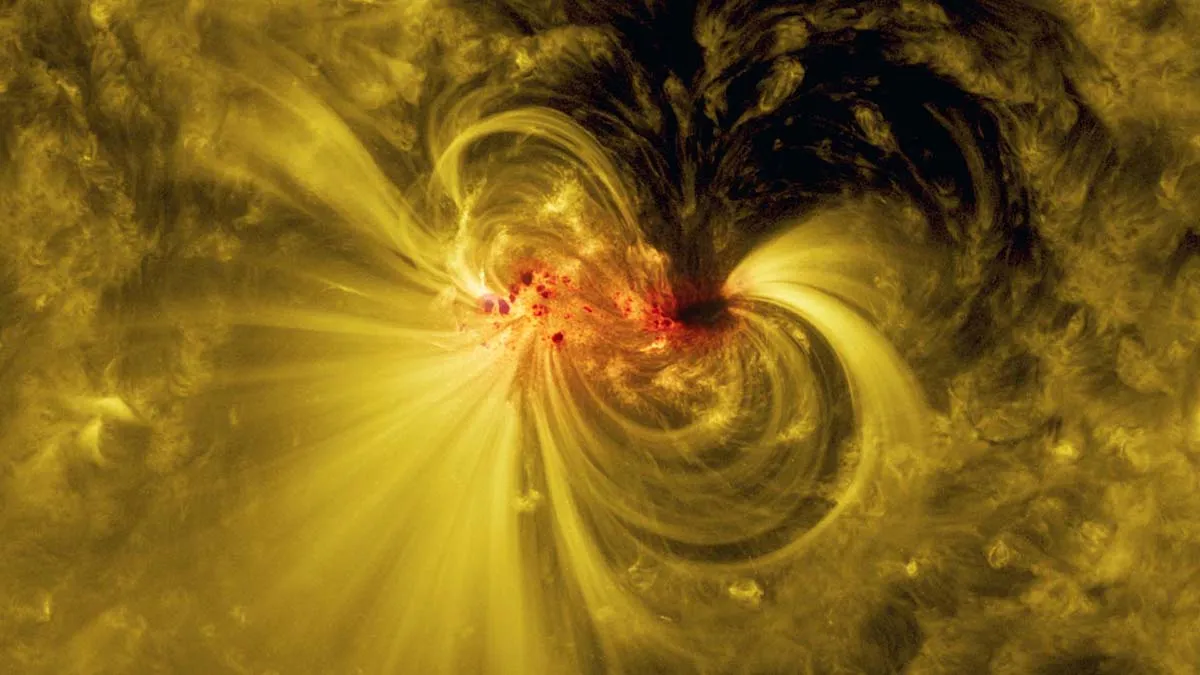Every object in our Solar System is shaped by and behaves the way it does because of the Sun: a mass of churning, multi-layered boiling gas at its centre.
The Sun is the source of all life on Earth, thanks to our sweet spot in the ‘goldilocks zone’, 149 million km away from its 15 million°C core, so it's no surprise that solar science - the study of the Sun - is such an intriguing and ever-expanding field.
But how much do we know about Sun, how do scientists study the Sun, and what spacecraft are exploring its secrets?
If you'd like to do some solar science yourself, read our guides on how to safely observe the Sun and how to photograph the Sun.
History of solar study

The history of astronomy goes back so far, it can be hard to trace, but we know that studies of the Sun date back at least as far as the 7th century BC, when ancient astronomers observed spots on its surface with the naked eye.
Once Galileo turned his telescope skywards in 1609, the science took a leap forward, when he confirmed that the Sun rotated monthly as the position of the sunspots moved.

In the centuries since, the Sun’s features were counted, catalogued and photographed, the study of ‘space weather’ (the effect of solar wind and magnetic activity) gathered pace, and theoretical physicists battled with geologists and evolutionary biologists about the Sun’s age.
Evolutionary biologists won: radioactive dating of meteorites shows that the Sun is 4.6 billion years old.
But most of the Sun’s mysteries remained hidden, until the Space Race that took us to the Moon paved the way for spacecraft to make the long, perilous journey towards our star.
Understanding Solar Storms

Predicting when solar storms may hit Earth is one of the main aims of modern solar research, but worries about the risks posed by our star were the driving force behind missions as far back as the 1960s.
By then it was already known that while the Sun’s conniptions can lead to beautiful phenomena like the aurora – when a small fraction of solar wind particles leaks through our magnetic field, meets our atmosphere and glows prettily in green, pink and purple as they give up their energy – they can also be highly disruptive.

In 1859, an enormous solar flare unleashed a coronal mass ejection (CME) – billions of tonnes of particles ejected from the Sun's outer atmosphere – that just hours later slammed into Earth.
So powerful was its impact that sparks flew from power lines, fires ignited and telegraph operators received electric shocks.
12 amazing missions to study the Sun
Historic Solar Missions
1
Pioneer

NASA’s Pioneer 6, 7, 8 and 9 were one of the first spacecrafts designed to respond to the threat posed by solar storms and space weather.
Launched between 1965 and 1968, they formed a ring of solar weather stations spaced along Earth’s orbit to measure the solar wind, magnetic fields and cosmic rays.
Their findings were used to predict solar storms for commercial airlines, power and communication companies, and the military.
2
Helios-A and Helios-B

The Pioneer probes orbited within 0.8AU (astronomical units) of the Sun, but that's still roughly 120 million km away. Within just a few years, however, Helios 1 and Helios 2 pushed the envelope much further, setting a record that would stand for over 40 years.
A joint initiative between NASA and West Germany’s space agency DLR, these probes were launched in 1974 and 1976 respectively.
A view of the orbits of Helios 1 and Helios 2 (aka Helios A & Helios B) can be seen in an animation produced by NASA's Scientific Visualization Studio below.
Helios 2 settled into an orbit just 42.7 million km (0.29AU) from the Sun, setting a new record speed for a spacecraft in the process, travelling at 70km/s.
Although exposed to 11 times the amount of received heat in Earth’s orbit, it continued to perform magnetic field experiments and provide information on solar plasma, solar wind, cosmic rays and cosmic dust right up until 1980, when the radio transceiver finally failed.
Helios 1 managed to continue broadcasting telemetry data up until 1986. Both are still orbiting the Sun to this day.
3
STEREO

STEREO-A and STEREO-B, members of NASA’s Solar Terrestrial Probes Program that led the way at the start of the 21st century, were twin observatories capable of capturing unprecedented 3D views of CMEs evolving and moving through space.
While 1859’s storm is so far an anomaly, we can only imagine the effect that a similar direct hit would have on our modern electricity-dependent world. A storm of similar ferocity in 2012 luckily passed Earth’s orbit without striking the planet.
That storm did, however, whizz past NASA’s STEREO-A (Solar Terrestrial Relations Observatory) spacecraft, which clocked the CME as traveling at 3,500 km/s as it left the Sun.

Modern missions to study the Sun
The more recent solar missions are part of a fleet of over 20 probes and satellites that currently have their instruments trained on our star. Here are just a few of them.
4
SOHO

Circling the Sun now for over 25 years is ESA/NASA’s Solar and Heliospheric Observatory(SOHO). From its position at L1 (Lagrange point 1, a gravitationally balanced point 1.5 million km from Earth towards the Sun), its 12 state-of-the-art instruments had uninterrupted views of the Sun.
The mission has transformed our understanding of the Sun's deep core, chromosphere, transition region and corona, as well as scrutinising its seismology.
Having far exceeded its original two-year program, it now keeps constant watch for CMEs – it has detected more than 30,000 over its lifetime.
5
ACE

Also hanging out at Lagrange point 1 and heading for its quarter-century in solar orbit is NASA’s Advanced Composition Explorer (ACE).
Monitoring solar storms since 1998, it too delivers real-time reports on the stream of accelerated particles that constantly bombard Earth, using its six high-resolution sensors and three monitoring instruments, and is projected to have enough propellant to keep reporting until 2024.
6
Genesis

SOHO and ACE were briefly joined in 2001 by NASA’s Genesis. Tasked with studying the Sun’s composition, for two years it bathed in solar wind particles, before successfully managing to return a sample weighing no more than a few grains of salt to Earth for analysis.
7
Solar Dynamics Observatory

How does the Sun shine? Since its launch in 2010, the Solar Dynamics Observatory has investigated how the Sun creates solar activity and drives space weather, using its three instruments, the Atmospheric Imaging Assembly, EUV Variability Experiment and Helioseismic and Magnetic Imager.
Orbiting 35,800km above Earth, it measures the magnetic forces at play from deep in the Sun’s core to out in its outer atmosphere.
So far it has captured thousands of super-high-resolution images that reveal the solar atmosphere in multiple wavelengths.

Solar missions close to Earth
Not all missions to study the Sun stray so far from planet Earth. NASA and its partners take a ‘multipoint solar science’ approach, positioning spacecraft throughout space in order to combine and compare their data.
This meant that a CME in April 2020, for example, was detected by Solar Orbiter, SOHO, BepiColombo (on its way to Mercury) and STEREO-A.
Part of this mix are the many lesser known missions gauging the Sun’s effect from much nearer to Earth.
8
BARREL

The 2013–16 BARREL mission (Balloon Array for Radiation-belt Relativistic Electron Losses) sent up 47 27-metre diameter balloons from Antarctica and Sweden, much like NASA's ASTHROS mission.
Placed just 32km above Earth, they studied the radiation belts within Earth’s magnetosphere, part of the field that protects humans from incoming energy from the Sun.
Alongside the much higher-flyingVan Allen Probes, the mission discovered a new transient belt in our upper atmosphere, which was then observed to be summarily destroyed by a powerfulshock wavefrom theSun.
9
SORCE

Another is the SORCE mission (Solar Radiation and Climate Experiment). From 2003 to 2020, from its 645km altitude it precisely measured incoming x-ray, ultraviolet, visible, near-infrared and total solar radiation – critical to studies of the Sun’s effect on Earth, long-term climate change and the atmospheric ozone.
10
IRIS and Hinode

A mystery that’s puzzled astronomers for years is why, within the Sun’s atmosphere, is it hotter the further away you get from the surface: 3,700°C at the Sun’s surface, but about 500,000°C out at the top of the corona?
To try to answer this, NASA’s IRIS (Interface Region Imaging Spectrograph) satellite has been trying to fathom how materials move in the Sun’s chromosphere, the mysterious in-between layer above the surface and below the solar corona.

Recently, alongside the JAXA (Japan Aerospace Exploration Agency)/NASA Hinode satellite and a research rocket launched for just five minutes from New Mexico, the first multi-height map of the chromosphere’s magnetic field was measured, revealing huge variations within the layer.
Closest ever missions to the Sun
11
Parker Solar Probe

Amazingly, Helios-B’s 1976 42.7 million km record stood right up until 29 October 2018, when the Parker Solar Probe sailed past, becoming the closest any human-made object has ever been to the Sun.
And it will go even closer: in late 2024 its orbit will pass within 6.1 million km, into the Sun’s corona, where its 11.4cm-thick shields will endure temperatures exceeding 1,300°C.

There it will watch solar winds in their infancy, observe magnetic fields, plasma and energetic particles.
En route, it has already returned incredible views of Venus, a planet from which it is getting a gravity-assisted boost (see image above).
12
Solar Orbiter

The most complex scientific laboratory ever to have been sent to the Sun, ESA/NASA’s Solar Orbiter launched in February 2020.
It too will edge closer to the Sun than plucky Helios-B, swinging – with the help of five Venus fly-bys – within 0.28AU (42 million km) by the time its main science phase begins.
The orbiter will take images from closer than ever before, including pictures of the uncharted polar regions for the very first time.
Its steepest viewpoint won’t be reached until 2029, however, so it may be some time before we can expect answers about how solar storms and the 11-year solar cycle work.

"This is the first time that our in-situ instruments operate at such a close distance from the Sun, providing us with a unique insight into the structure and composition of the solar wind," says Yannis Zouganelis, ESA’s Solar Orbiter Deputy Project Scientist.
"For the in-situ instruments, this is not just a test, we are expecting new and exciting results."

Already, in fact, Solar Orbiter's first images are shaking up our understanding. They show a multitude of ‘campfires’, tiny solar eruptions bursting across the surface of the Sun.
By matching the Sun’s speed of rotation, Solar Orbiter will be able to hover above features like this to examine them over time.
Future solar missions

And the solar mission launches continue. NASA’s SunRISE (Sun Radio Interferometer Space Experiment), ESA’s Proba-3 and the ESA/Chinese Academy of Sciences’ SMILE (Solar wind Magnetosphere Ionosphere Link Explorer) are all slated for launch in 2023, with JAXA’s Solar-C following not far behind.
It would surely boggle Galileo’s mind to see how far we’ve come, how much more we know and how close we are getting to actually touching our Sun, since that moment when he first turned his telescope to the sky and spotted spots on the surface of our star.
Jane Williamson is a science journalist and writer.

